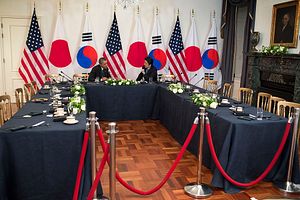Tensions between Japan and South Korea are an ongoing concern, with controversies relating to historical issues periodically souring diplomatic relations. Japan recently sent its ambassador back to South Korea after a three-month absence following the placement of another “comfort woman” statue. The Japan-ROK relationship sometimes prevents top-level trilateral summits with the United States: Prime Minister Shinzo Abe and former Presidents Park Geun-hye and Barack Obama only managed to meet twice on the sidelines of the 2014 and 2016 Nuclear Security Summits, at the urging of Obama, to discuss regional security. Abe and Park met twice as well in 2015 and 2016.
However, lower-level trilateral meetings on security issues, particularly North Korea, are held with regularity, most recently the 9th Defense Trilateral Talks this April in Japan. The three militaries have also conducted joint exercises, including a new anti-submarine warfare drill this year. Such functional steps are necessary to prepare trilateral responses to regional threats.
Yet now, more than ever before, the top-level summits matter. The new ROK president to be elected on May 9 will likely make changes to former President Park’s hardline policy. The U.S. policy towards North Korea is also in flux. President Donald Trump seemed to give China pause when he declared, days before the April 6 summit with Chinese President Xi Jinping, that the U.S. would consider unilateral action if China did not agree to cooperate vis-à-vis North Korea. China agreed to increase cooperation on April 7, and by April 17, White House Press Secretary Sean Spicer told the press that the Trump-Xi summit was “paying off” and China was already “playing a much more active role.” When asked about China’s actions, Spicer cited the suspension of coal imports from North Korea, China took this action back in February. Trump accepted China’s promise as good enough, asking rhetorically, “Do I want to start heavy, heavy trade or currency manipulation statements against someone who’s out there trying to stop what could be a very bad situation?”
The administration has also swung between an impulse to show force and a willingness to try negotiation: the aircraft carrier Carl Vinson was (mistakenly) said to be going to the Korean Peninsula as a warning to North Korea on April 9, but Press Secretary Spicer said on April 17 that the administration would not draw any “red lines” with North Korea. On the same day, Vice President Mike Pence announced, while visiting the demilitarized zone between North and South Korea, that “all options are on the table,” though the U.S. sought stability “through negotiation.” What direction the U.S. policy towards North Korea will take under Trump is guesswork. But the administration intends to prioritize North Korea as an issue that requires international cooperation.
Some argue that China’s assistance is important, especially because any economic sanctions will fail without China’s cooperation as North Korea’s largest trading partner. China is also obligated by treaty to assist militarily should North Korea be attacked. Effective action needs Chinese cooperation to minimize the potential for devastating side conflicts. But Japan and South Korea must not let the Trump administration’s focus on gaining China’s cooperation allow the North Korea policy to be shaped by primarily the U.S. and China, particularly if the Trump administration fails to hold China to its promises. Lower-level trilateral meetings might become less efficient in planning policy implementation if the messages coming from the top begin to diverge or confuse.
Trump is interested in working with U.S. allies, as indicated by an April 13 tweet and his calls to Japan and South Korea on Syria and North Korea. Top-level meetings with Abe and the next ROK president can reinforce Trump’s interest by showing him the benefits of close cooperation. Abe and the next ROK president must delve into the regional intricacies of the North Korea threat with Trump (which he has heard from the Chinese perspective), so that he can incorporate the interests of the two allies. Abe and the ROK president can also discuss past policy approaches, ranging from hard to soft, and their combined influence might temper Trump’s North Korea policy and prevent it from unexpectedly changing course.
If top-level trilateral meetings occur regularly, the benefits can expand beyond immediate security concerns. The three countries share interests in other areas of international relations, such as trade, economic development, peacekeeping, and international norms. Relations between Japan and South Korea might accumulate goodwill if the leaders can demonstrate the positive impact of cooperation. Indeed, the future of trilateral meetings might depend on Japan-ROK collaboration. There is no guarantee that Trump will press Abe and the next ROK president to meet; instead, they might need to persuade Trump to join them. South Korea and Japan would do well to leverage trilateral cooperation soon, not only for North Korea but for broader impact and the opportunity to shape U.S. policies that value allies.
Pamela Kennedy is a Research Associate in the East Asia Program at the Stimson Center.

































